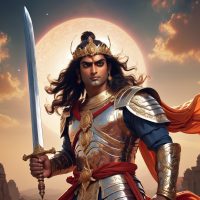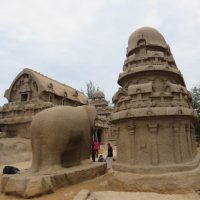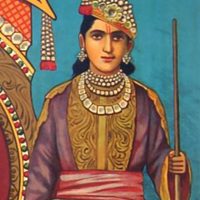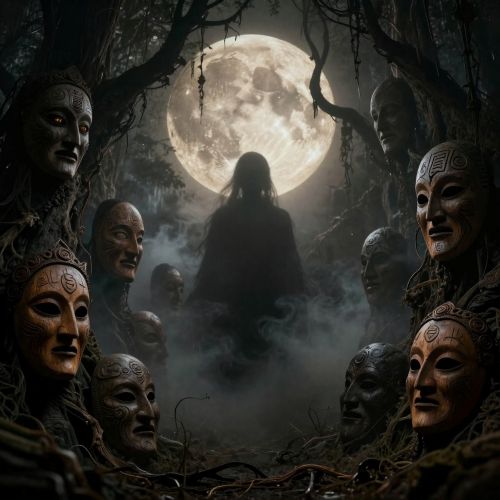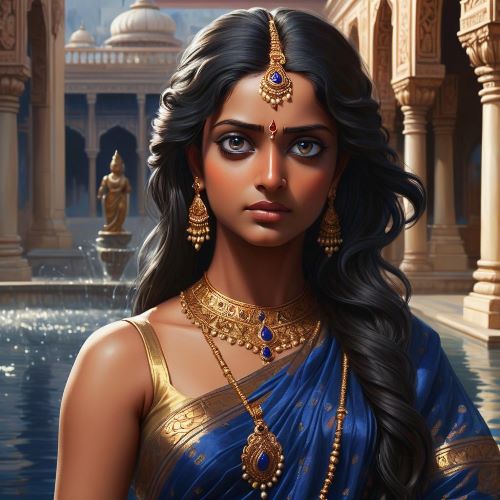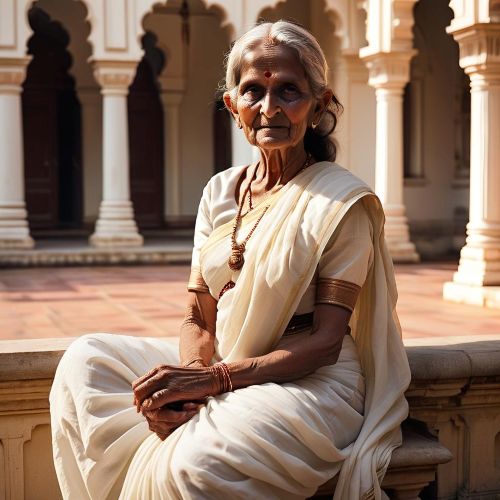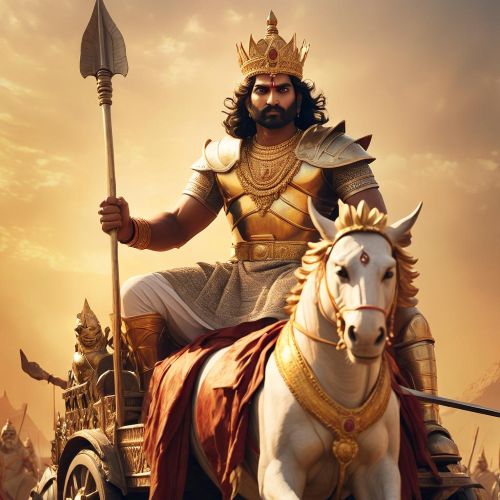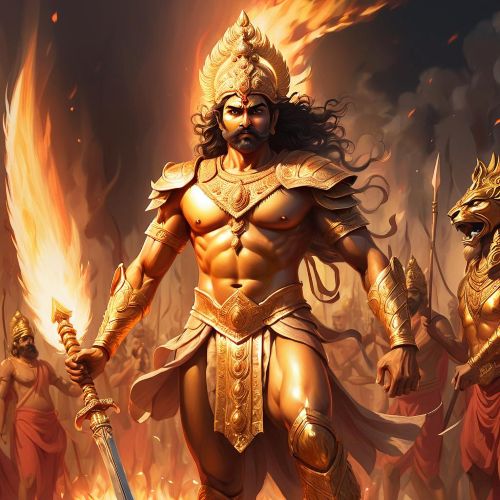Sahadeva : The Wisest Pandava
Listen
Sahadeva
Introduction
In the vast narrative of the Mahabharata, Sahadeva stands as one of its most intriguing and underappreciated figures. The youngest of the five Pandava brothers, he is often overshadowed by the larger-than-life presence of Arjuna’s valor, Bhima’s strength, and Yudhishthira’s righteousness. Yet, Sahadeva represents the essence of quiet intelligence, self-restraint, and unshakable loyalty. His name, derived from Sanskrit—Saha (with) and Deva (gods)—literally means “one with the gods,” reflecting both his divine origins and his spiritually elevated nature. Born to the celestial Ashvini Kumaras through Queen Madri, Sahadeva embodies a balance between intellect and virtue, symbolizing the power of wisdom guided by humility.
Physical Traits
Sahadeva’s appearance mirrors his divine parentage and princely birth. Ancient texts describe him as handsome, radiant, and noble, sharing a striking resemblance with his twin brother, Nakula. His demeanor was calm and introspective, his eyes sharp with perception and understanding. Unlike Bhima’s formidable physique or Arjuna’s martial poise, Sahadeva’s elegance lay in his grace and composure. His beauty was said to be so captivating that during the Pandavas’ exile, he deliberately smeared his face with dust to conceal his looks and avoid unwanted attention. Often depicted with a sword in hand and clothed in regal attire, Sahadeva exemplified the perfect Kshatriya—refined, disciplined, and ever ready to serve his dharma.
Family
Sahadeva was born to King Pandu and Queen Madri through the divine intervention of the Ashvini Kumaras, the twin gods of medicine and healing. His twin brother, Nakula, shared both his appearance and his affinity for wisdom. Alongside their elder half-brothers—Yudhishthira, Bhima, and Arjuna—the five were collectively known as the Pandavas. Their early years were spent under the tutelage of sages in the forest, where Sahadeva developed his intellect and spiritual depth.
In marriage, Sahadeva followed the shared bond of Draupadi, who became the wife of all five Pandavas, a union symbolizing equality and unity. From her, he had a son named Shrutasena, also known as Shrutakarma in some traditions. Sahadeva later married Vijaya, the daughter of King Dyutimata of the Madra kingdom, with whom he had another son, Suhotra. His family ties extended deeply into the political alliances and emotional fabric of the Mahabharata—particularly through his maternal uncle, King Shalya, who would later fight on the side of the Kauravas, intensifying Sahadeva’s inner conflicts of duty versus kinship.
Other names
Sahadeva is known by many epithets across different texts, each shedding light on a facet of his character. He is called Ashvineya and Ashvinisuta, acknowledging his divine heritage as the son of the Ashvini twins. Madreya and Madriputra denote his maternal lineage to Queen Madri, while Nakulaanuja simply means “younger brother of Nakula.” In his period of exile and disguise, Sahadeva assumed the name Tantipala, serving as a cowherd in King Virata’s court—a reflection of his humility and versatility. Many texts also describe him with attributes such as Vidvān (wise), Prājña (intelligent), and Dharmika (righteous), emphasizing his wisdom and moral clarity. Collectively, these names portray Sahadeva as not merely a warrior prince but a thinker, seer, and moral philosopher.
Powers and Abilities
Among all the Pandavas, Sahadeva was distinguished by his deep knowledge of astrology, foresight, and political science. It is said that he possessed the divine gift of knowing the past, present, and future—a blessing granted by the gods. Yet, this gift came with a condition: if he ever revealed his knowledge unasked, his head would shatter into fragments. Bound by this vow, Sahadeva remained silent about many crucial events, including the outcome of the Kurukshetra war, which he foresaw long before it began.
Trained under Dronacharya, Sahadeva mastered swordsmanship and became one of the Pandavas’ finest swordsmen. His precision and composure in battle earned him recognition as a Maharathi, a warrior capable of facing multiple opponents simultaneously. Before Yudhishthira’s Rajasuya Yagna, he led a successful southern campaign, subduing kingdoms through both diplomacy and combat, extending the Pandava influence as far as Rameshwaram and the islands beyond. During the Kurukshetra War, Sahadeva fulfilled his vow of vengeance by slaying Shakuni, the mastermind behind the infamous game of dice that had humiliated their family. He also killed Shakuni’s son, Uluka, and fought fearlessly against the formidable warriors of the Kaurava army, demonstrating not just valor but divine precision.
Beyond his martial skills, Sahadeva inherited the medical and scientific knowledge of his divine fathers. He was well-versed in Ayurveda, veterinary science, and the care of horses and cattle, reflecting the Ashvini Kumaras’ celestial mastery of healing and medicine. His understanding of Nitishastra (statecraft and ethics), learned under the divine teacher Brihaspati, made him an adept advisor, blending moral reasoning with political strategy. These attributes made him a figure of balance—both a warrior and a philosopher, embodying the complete ideal of a Pandava.
Modern Day Influence
Sahadeva’s influence extends far beyond the pages of the Mahabharata. In modern Indian culture, he is celebrated as the archetype of the wise and humble leader—one who wields knowledge responsibly and acts with quiet dignity. His restraint in speech and action is seen as a lesson in self-discipline, a reminder that true power often lies in silence and understanding rather than outward aggression.
In South India, Sahadeva is revered as a master astrologer, and many local traditions associate him with the foundations of Jyotisha (Vedic astrology). His character continues to inspire scholars and spiritual thinkers exploring the intersections of fate, karma, and divine order.
Modern retellings of the Mahabharata—from television adaptations to literary reinterpretations—often depict Sahadeva as the voice of calm reason amidst chaos. His subtle wisdom appeals to contemporary audiences seeking spiritual balance in a world driven by ambition and noise. Artists and dramatists portray him as a symbol of introspection, while leadership theorists cite him as an example of “quiet strength,” representing those who guide with intellect and empathy rather than dominance.
Sahadeva’s enduring presence in modern thought underscores the timeless relevance of his virtues. His story reminds us that wisdom, when paired with humility and action, becomes a force of transformation. In an era that often glorifies power and visibility, Sahadeva’s legacy stands as a testament to the unseen brilliance of those who lead with knowledge, compassion, and quiet determination.
Related Images
Source
Wikipedia contributors. (2004, December 24). Sahadeva. Wikipedia. https://en.wikipedia.org/wiki/Sahadeva
HinduPedia. (n.d.). Sahadeva. https://www.hindupedia.com/en/Sahadeva
World Mythos. (2024, December 18). Sahadeva. https://worldmythos.com/sahadeva/
Wikipedia contributors. (2007, December 1). Sahadeva of Magadha. Wikipedia. https://en.wikipedia.org/wiki/Sahadeva_of_Magadha
Scribd. (2025, May 1). Vipaka [PDF]. https://www.scribd.com/doc/162964868/Vipaka
Nachiketa. (2020, November 2). 108 Facts (Part 1). https://nachiketa.org/108-facts-part-1/
Wisdom Library. (n.d.). Story of Sahadeva. https://www.wisdomlib.org/hinduism/compilation/puranic-encyclopaedia/d/doc241902.html
OAPEN Library. (n.d.). Visions and Revisions in Sanskrit Narrative [PDF]. https://library.oapen.org/bitstream/20.500.12657/87983/1/book.pdf
Debroy, B. (2015). The Mahabharata: Volume 1–10. Penguin Books.
Ganguli, K. M. (Trans.). (1883–1896). The Mahabharata of Krishna-Dwaipayana Vyasa. Sacred-texts.com.
Hiltebeitel, A. (2001). Rethinking the Mahabharata: A Reader’s Guide to the Education of the Dharma King. University of Chicago Press.
Narayan, R. K. (1978). The Mahabharata: A Shortened Modern Prose Version. University of Chicago Press.
Pattanaik, D. (2010). Jaya: An Illustrated Retelling of the Mahabharata. Penguin India.
Frequently Asked Questions
What is lorem Ipsum?
I am text block. Click edit button to change this text. Lorem ipsum dolor sit amet, consectetur adipiscing elit. Ut elit tellus, luctus nec ullamcorper mattis, pulvinar dapibus leo.
What is lorem Ipsum?
I am text block. Click edit button to change this text. Lorem ipsum dolor sit amet, consectetur adipiscing elit. Ut elit tellus, luctus nec ullamcorper mattis, pulvinar dapibus leo.
What is lorem Ipsum?
I am text block. Click edit button to change this text. Lorem ipsum dolor sit amet, consectetur adipiscing elit. Ut elit tellus, luctus nec ullamcorper mattis, pulvinar dapibus leo.
What is lorem Ipsum?
I am text block. Click edit button to change this text. Lorem ipsum dolor sit amet, consectetur adipiscing elit. Ut elit tellus, luctus nec ullamcorper mattis, pulvinar dapibus leo.
What is lorem Ipsum?
I am text block. Click edit button to change this text. Lorem ipsum dolor sit amet, consectetur adipiscing elit. Ut elit tellus, luctus nec ullamcorper mattis, pulvinar dapibus leo.


